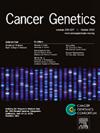基于病毒基因型的人乳头瘤病毒相关头颈癌的生物学景观
IF 2.1
4区 医学
Q4 GENETICS & HEREDITY
引用次数: 0
摘要
人乳头瘤病毒(HPV),特别是16和18株,即使在不吸烟和不饮酒的人群中也会导致口咽鳞状细胞癌(OPSCC)。本研究根据病毒基因型研究hpv阳性OPSCCs的基因表达变化。对36例p16阳性OPSCC患者的RNA测序分析显示,仅E6/E7转录本(E6E7)和额外E5转录本(E5-added)的肿瘤之间的表达模式不同。E6E7组fos相关通路和NF-κB信号通路被激活。值得注意的是,与肿瘤生长和癌症抗原相关的基因在两组之间存在差异。这些发现表明,HPV E5的存在可能影响转化阶段和基因表达,潜在地影响患者的预后。e5添加组表达了多种癌症相关抗原,为hpv阳性OPSCC的个性化免疫治疗方法提供了潜在靶点。本文章由计算机程序翻译,如有差异,请以英文原文为准。
Biological landscape of human papilloma virus-related head and neck cancer according to virus genotype
Human papillomavirus (HPV), particularly strains 16 and 18, contributes to oropharyngeal squamous cell carcinoma (OPSCC), even in non-smokers and non-drinkers. This study investigated gene expression variations in HPV-positive OPSCCs according to the virus genotype. An RNA sequencing analysis of 36 p16-positive OPSCC patients revealed distinct expression patterns between tumors with only E6/E7 transcripts (E6E7) and those with additional E5 transcripts (E5-added). The E6E7 group displayed activation of FOS-related pathways and the NF-κB signaling pathway. Notably, the genes associated with tumor growth and cancer antigens differed between the groups. These findings suggest that the presence of HPV E5 might influence the transformation stages and gene expression, potentially affecting patient outcomes. The E5-added group expressed multiple cancer-associated antigens, presenting potential targets for personalized immunotherapy approaches for HPV-positive OPSCC.
求助全文
通过发布文献求助,成功后即可免费获取论文全文。
去求助
来源期刊

Cancer Genetics
ONCOLOGY-GENETICS & HEREDITY
CiteScore
3.20
自引率
5.30%
发文量
167
审稿时长
27 days
期刊介绍:
The aim of Cancer Genetics is to publish high quality scientific papers on the cellular, genetic and molecular aspects of cancer, including cancer predisposition and clinical diagnostic applications. Specific areas of interest include descriptions of new chromosomal, molecular or epigenetic alterations in benign and malignant diseases; novel laboratory approaches for identification and characterization of chromosomal rearrangements or genomic alterations in cancer cells; correlation of genetic changes with pathology and clinical presentation; and the molecular genetics of cancer predisposition. To reach a basic science and clinical multidisciplinary audience, we welcome original full-length articles, reviews, meeting summaries, brief reports, and letters to the editor.
 求助内容:
求助内容: 应助结果提醒方式:
应助结果提醒方式:


